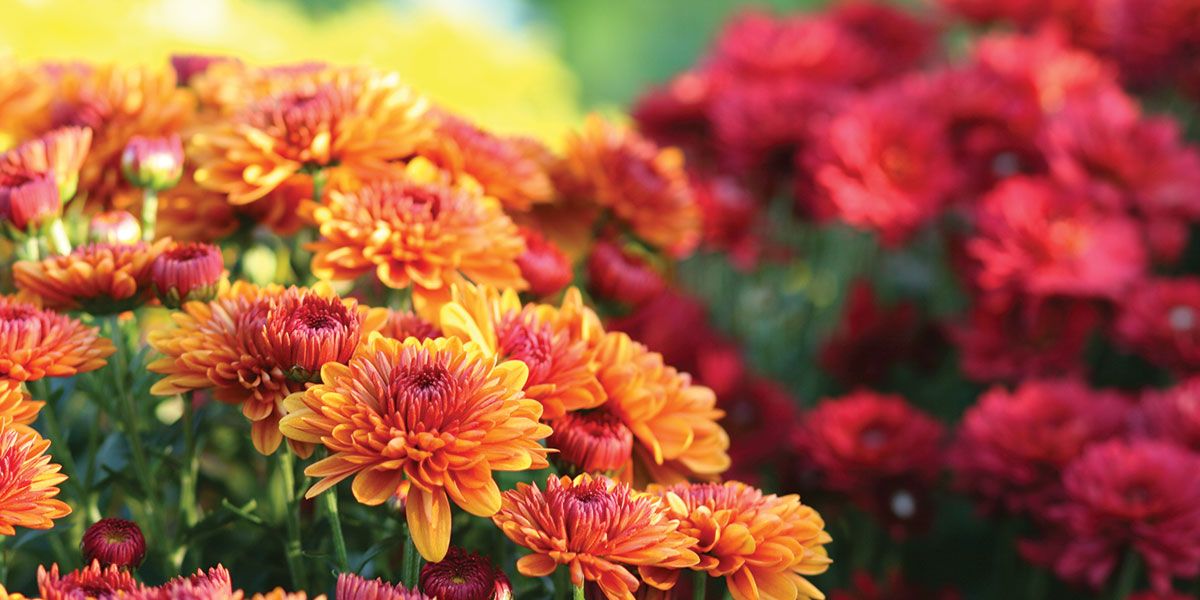CHRYSANTHEMUMS

The quintessential flower of fall
As the vibrant colors of summer begin to fade and the crisp air of autumn takes over, one flower emerges to steal the spotlight: the chrysanthemum. Fondly known as “mums,” these blooms have become synonymous with fall, adorning gardens, porches and homes with their striking colors and varied forms. But what makes chrysanthemums the flower of fall, and how can you ensure your potted mums thrive throughout the season? Let’s delve into the captivating world of chrysanthemums, from their rich history to their care, tips for using them in fall décor and how to plan for post-season upkeep of your plants.
A brief history
Chrysanthemums, native to Asia and northeastern Europe, have a history that dates back over 2,500 years. The name “chrysanthemum” is derived from the Greek words “chrysos” (meaning gold) and “anthemon” (meaning flower). This flower was first cultivated in China as a flowering herb, and it soon became a symbol of nobility and longevity. Chinese culture regarded it so highly that only royals were allowed to grow it.
Mums were introduced to America in the late 18th century as an import from Asia. The flower’s popularity grew in the 19th century, especially with the formation of the National Chrysanthemum Society in 1889. Plants that you can purchase today can be broadly classified into garden mums, which are hardier for outdoors, and florist mums.
The flower of fall
The association of chrysanthemums with fall can be attributed to their blooming season. As summer perennials and annuals start to wither, chrysanthemums burst into bloom, providing a splash of color when most other flowers are beginning to fade. Their ability to withstand cooler temperatures makes them a perfect choice for autumn gardens and decorations.
 Watering and fertilizing
Watering and fertilizing
For the healthiest and most vibrant potted chrysanthemums, proper watering and fertilizing are essential. Chrysanthemums prefer consistently moist soil, but they don’t like to be waterlogged. To achieve this balance, water your potted mums when the top inch of soil feels dry to the touch. Depending on the weather, this might mean watering every two to three days. In particularly hot or windy conditions, you might need to water daily.
Ensure good drainage by using pots with drainage holes and avoid letting the plants sit in standing water. Overwatering can lead to root rot, while underwatering can cause the plant to wilt and the flowers to fade prematurely.
Fertilizing your chrysanthemums is key to promoting healthy growth and abundant blooms. Use a balanced, water-soluble fertilizer with an equal ratio of nitrogen, phosphorus and potassium (such as 10-10-10 fertilizers). Start fertilizing in early spring when new growth begins and continue every two weeks until the buds start to show color. Once the flowers begin to open, you can reduce the frequency to once a month. Avoid fertilizing after the first frost, as this can encourage new growth that won’t survive the colder temperatures.
Post-season care
As the fall season draws to a close and the chrysanthemums begin to fade, many gardeners wonder what to do with their potted mums. The good news is that chrysanthemums are perennials, meaning they can come back year after year with proper care.
One option is bringing your potted chrysanthemums indoors to overwinter. Place the pots in a cool, dark location like a basement or garage, and water sparingly — just enough to keep the soil from completely drying out. Once spring arrives and the danger of frost has passed, you can move the pots back outside. Click her to read our article for more tips on bringing your plants inside!
For those in milder climates, such as zones 5-9, which includes our region in Virginia, you may wish to plant your mums in the ground. Here’s how to do it:
- Location: Find a sunny spot in your garden with well-draining soil. Chrysanthemums thrive in full sun, so aim for at least six hours of sunlight per day.
- Soil: Work some compost or well-rotted manure into the soil to improve fertility and drainage.
- Transplanting: Dig a hole that is twice the size of the pot your mum is in. Carefully remove the plant from its pot, loosen the roots, and place it in the hole. Backfill with soil and water thoroughly.
- Mulching: Apply a layer of mulch around the base of the plant to help retain moisture and protect the roots from freezing.
- Pruning: After the first hard frost, cut back the stems to about 6 inches above the ground. This helps the plant conserve energy and promotes healthy growth in the spring.
Chrysanthemums, with their rich history and vibrant fall blooms, are a delightful addition to any garden or home. By understanding their needs and providing the right care, you can enjoy their beauty throughout the season and beyond.
Tips for using mums in fall décor
Chrysanthemums are not only beautiful garden plants but also versatile elements for fall décor. Here are some creative ways to incorporate mums into your autumnal arrangements:
PORCH AND ENTRYWAY DISPLAYS
Welcome guests with a warm and vibrant display of chrysanthemums. Combine pots of mums with pumpkins, gourds, corn stalks or hay bales for a classic fall look.
CENTERPIECES AND TABLE ARRANGEMENTS
Pair smaller pots of mums with candles, pinecones and autumn leaves for a festive and cozy display.
WINDOW BOXES AND HANGING BASKETS
Brighten up your windows and patios with mums in window boxes and hanging baskets. Mix them with other fall plants like ornamental kale, pansies and ivy to enhance the seasonal charm.
WREATHS AND GARLANDS
Craft a unique fall wreath or garland using dried chrysanthemum blooms. Combine them with other dried flowers, wheat stalks and ribbons to create a beautiful decoration for your front door or mantel.
INDOOR DISPLAYS
Bring the beauty of chrysanthemums indoors by placing potted mums around your home. Make sure they get plenty of light to keep them healthy and blooming. ✦
“anthemon”, “chrysos”, autumn gardens, centerpieces and table arrangements, Chrysanthemum, indoor displays, mums, Perennials, porch and entryway displays, post-season, vibrant fall blooms, window boxes and hanging baskets, wreaths and garlands











